This Class is Part of the
Black Friday Week of Thanks Sale
HipHarpAcademy.com Presents
Deborah Henson-Conant’s Online Learning Experience
Hands-on-Harmony
What if you could learn all the basics of harmony & theory – playing while you learn – and learning while you play?
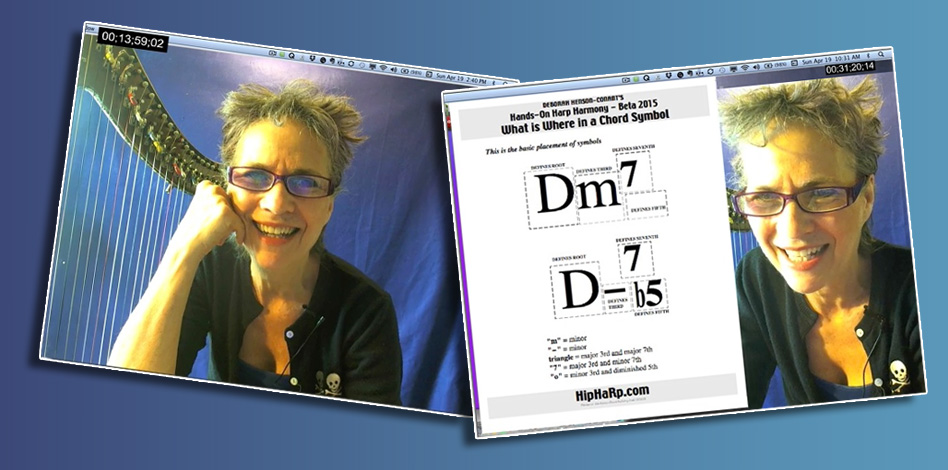
I always wondered what made some harp players pull my heart strings and astonish me with their beauty, and others “not so much”. Here’s where I found out. The difference is in the harmonies and the great lessons on extending the harmonies. You will LOVE this. It will totally change your playing.
Black Friday Special! $297 $147 (50% off!)
Registration includes 6-Month Access PLUS downloadable audio & pdf files for your personal learning library.
As with most stand-alone classes through the Academy, you can upgrade to full membership any time up to 30 days after you purchase the class and apply 100% of what you paid for this class to your membership — so it’s a great starter class for those considering the Academy.
Got Questions? Use the “Ask-a-Question” form to get a quick answer.
HARMONY FOUNDATION from a Harpist’s perspective.
“Hands on Harmony” is the only harmony/theory training specifically for harpists – using the way our instrument works – with lots of ‘hands-on’ examples so you can practice what you’re learning and literally get it ‘into your fingers.’ The class covers the four quadrants of basic tonal and jazz harmony – extension, alteration, substitution and progressions – as well as covering ‘families’ of chords and basic modulation skills.
This self-paced training starts with a SINGLE NOTE and walks you through the 3 phases of chord-construction: Expansion, Alteration & Substitution – and then beyond, to the art of progressions and modulation – all at your own pace. You go as far as you want each session, then apply what you learn in the exercises, warmups and tunes.
Originally a 6-Hour Immersion Training, “Hands on Harmony” On-Demand has been carved into nice little bite-sized modules with examples and warmups so everything you learn goes directly into your hands.
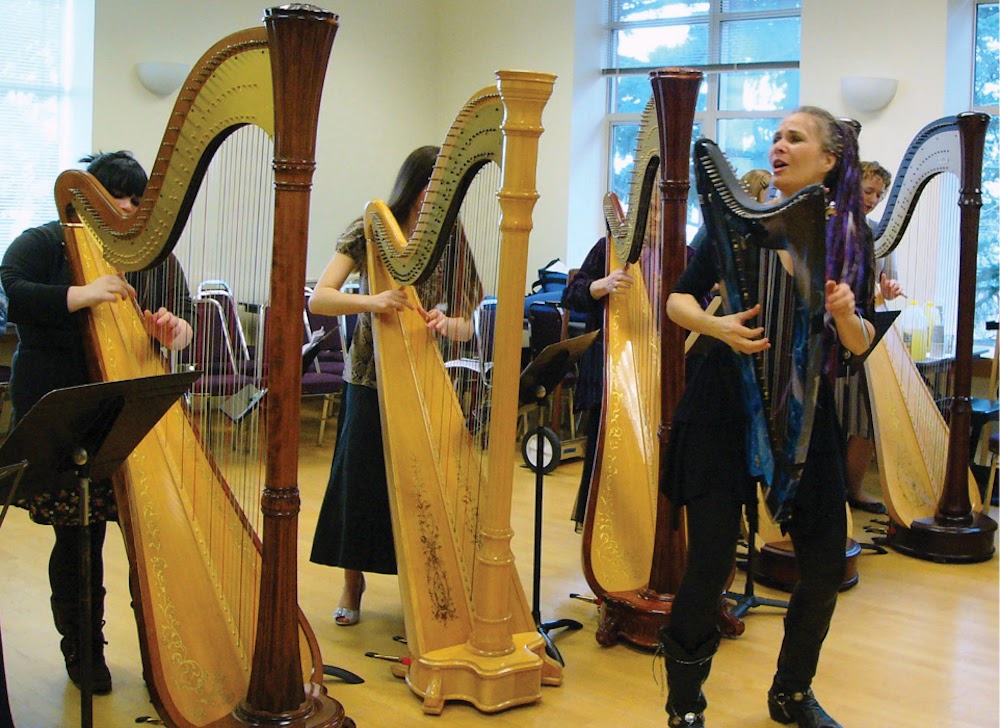
By the end of the class …
By the end of the class, you’ll be able to:
- Read CHORD SYMBOLS on a LEAD SHEET and know what the different elements of the symbol mean.
- EXPAND chords, from single notes to triads, 7ths, 9th, 11ths and 13th and know what’s likely to sound good (or bad!).
- ALTER chords – by adding a b9, #9, b5 or #5 – to make them richer (and know what chords are best to alter!).
- SUBSTITUTE one chord for another to ‘reharmonize’ a piece, knowing which substitutions are simplest, and which chords you’re most likely to create substitutes for.
- See and create PROGRESSIONS, know how to look for them in the music you already play and use them for improv, or to practice the skills of expanding, altering and substituting chords.
- MODULATE from one key to another using a “diversion” and a power progression
- ‘Psyche out’ a LEAD SHEET to look for members of the same chord family, so you can more easily see where you need to shift your levers or pedals.
What harpists say about “Hands on Harmony”
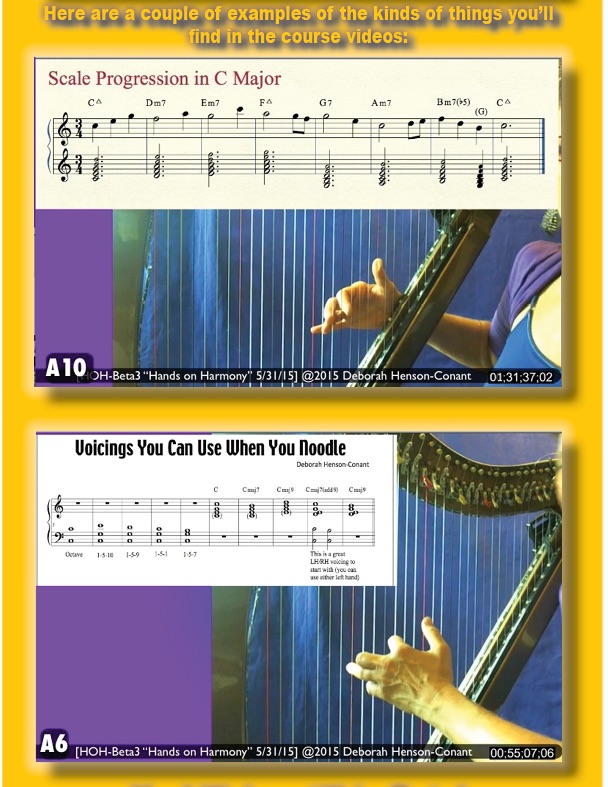
Black Friday Special! $297 $147 (50% off!)
Registration includes 6-Month Access PLUS downloadable audio & pdf files for your personal learning library.
As with most stand-alone classes through the Academy, you can upgrade to full membership any time up to 30 days after you purchase the class and apply 100% of what you paid for this class to your membership — so it’s a great starter class for those considering the Academy.
Got Questions? Use the “Ask-a-Question” form to get a quick answer.
Get the Course a la Carte or with Academy Membership
Hands on Harmony is included in the “Jazz for Harps” program and Hip Harp Academy membership – or you can purchase it separately as a stand-alone class. It’s a powerful training on its own – and it’s a pre-cursor to any of the improv classes in the Academy.
As with most stand-alone classes through the Academy, you can upgrade any time up to 30 days after you purchase the class and apply 100% of what you pay for this class to your membership — so it’s a great starter class for those considering the Academy.
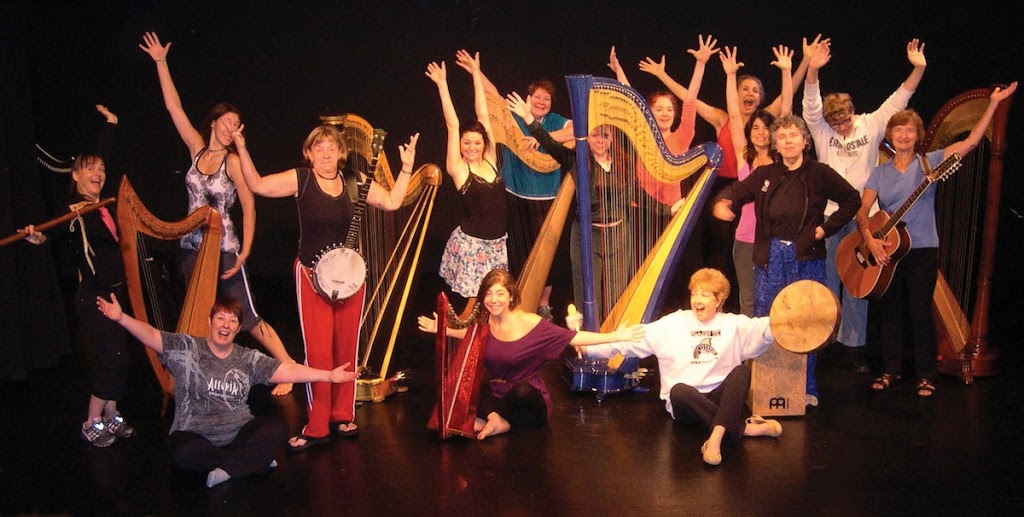
How does the course work, exactly?
“Hands on Harmony” is an online class that’s ‘go at your own pace.’ You’ll get 6 month’s access to the classroom so you can take it as slow or as fast as you want and you can take the lessons whenever YOU want – from your computer, your phone or your iPad.
You’ll be able to download all the PDFs and Audio files – so you’ll have them on your own computer forever if you want – and you’ll have access to the video lessons in the classroom for 6 months. (Don’t worry – we’ll give you 2 weeks warning before your access ends just in case you haven’t downloaded the files yet.)
It’s all pre-recorded, so you don’t have to schedule a lesson or worry about missing a class.
Watching the lessons is like watching YouTube – but they’re playalong lessons, so you play along on your harp. The training broken into bite-size modules with a lot of exercises to get the learning into your HANDS.
“Hands on Harmony” was originally recorded as a full-day online retreat, so it’s casual and fun. We then edited the videos and added some from other online events I’ve done so that it covers a wide swath of harmony training — starting from the basics of how chords are built to how to extend, alter and substitute them – and how to use them in harmonic progressions
Once every 2-3 Years there’s a LIVE “Hands on Harmony” Intensive, which usually lasts anywhere from a single LOOOONG day to a week or two.
Most importantly – it’s all about YOUR HANDS on YOUR HARP
So you’re playing as you learn – and learning as you play.
Black Friday Special! $297 $147 (50% off!)
Registration includes 6-Month Access PLUS downloadable audio & pdf files for your personal learning library.
As with most stand-alone classes through the Academy, you can upgrade to full membership any time up to 30 days after you purchase the class and apply 100% of what you paid for this class to your membership — so it’s a great starter class for those considering the Academy.
Got Questions? Use the “Ask-a-Question” form to get a quick answer.
How can one Harmony Course work for ALL levels of players??
Once you know the basic concept in its simplest form, pattern and shape you can embellish and expand it infinitely. The key is understanding the basic, simple concept in a way that CLICKS with your mind and your hands.
That’s how I learn — and that’s how I teach – and that’s why I’m still fascinated and still exploring the same basic ideas after decades of playing with them.
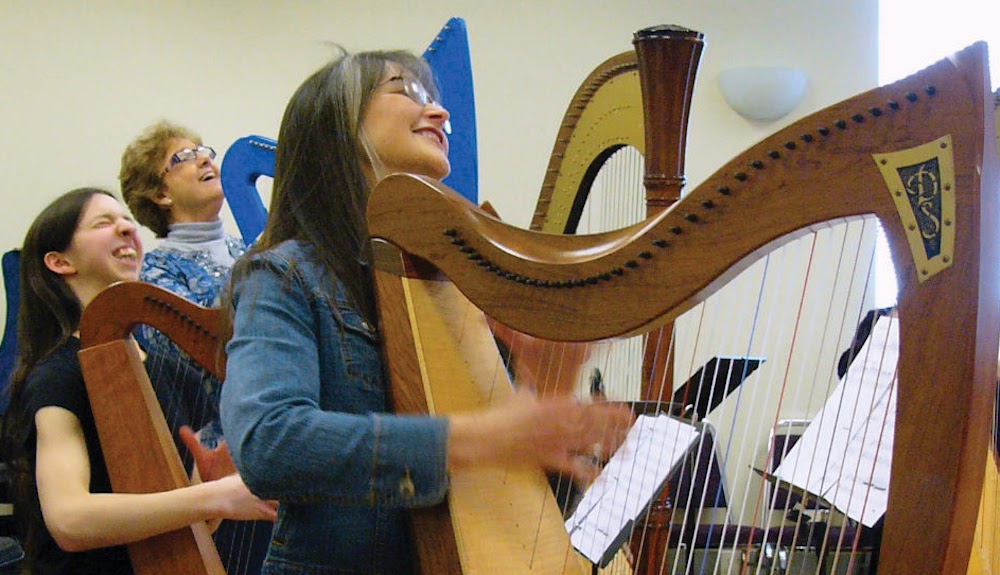
Invest in Your Creative Freedom
Sign up for Self-Paced “Hands on Harmony”
(Includes 6-Months Access)
Black Friday Special! $297 $147 (50% off!)
(credit card or PayPal)
This class is included, along with dozens of other classes, along with coaching & community in the Yearly “Hip Harp Academy” Membership:
Your Investment: $1997
(credit card or PayPal)
Payment Plans Available
Already a Current Member of Hip Harp Academy Full-Level?
This program is INCLUDED the year-long Hip Harp Academy curriculum — so if you’re a current member, get ready to jazz it up! If your membership is ending – keep an eye out for the renewal info so you don’t miss the fun!
If you’re NOT in the Academy and you want to make sure to get absolutely everything, including a full year of classes at Hip Harp Academy check out Hip Harp Academy Yearlong Membership Here or just register here. Hip Harp Academy Full Yearlong Membership combines Classes, Coaching & Community – with classes like “Hands on Harmony”, “Blues HarpStyle,” “Jazz for Harps” PLUS over a dozen other classes like “Hip Harp Toolkit / Arrange Yourself,” “Strings of Passion,” “Baroque Flamenco Beyond the Page.” If you have questions about how it works, just email using my Ask a Question Form.
Why I Created This Class for YOU.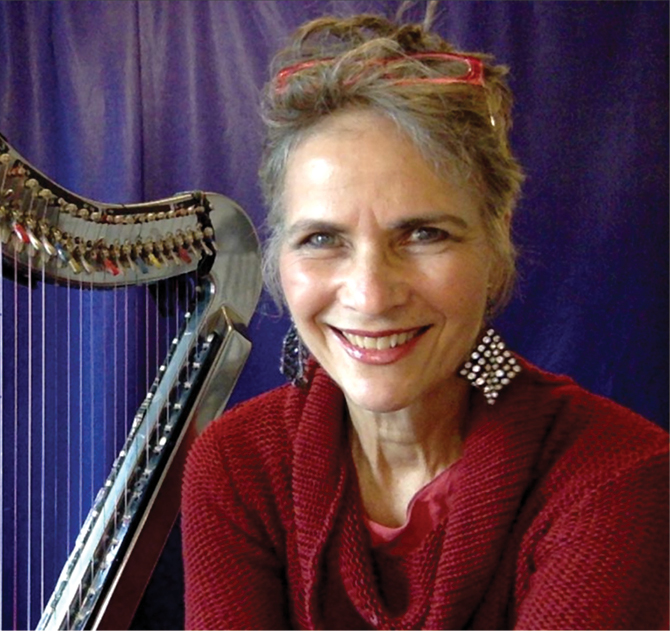
Hi, I’m Deborah Henson-Conant, and I’ve been composing, arranging and creating shows since I was a kid. I now play shows with symphonies and on solo stages with the electric harp that was created for me by CAMAC Harps, the “DHC” electric harp.
But I started on the ukulele, playing and singing with my mom – and playing piano just for fun.
When I was 10, she taught me how to read chords on the piano, and from there I learned about how to expand chords to 7th and 9ths, and how to alter them with “flat-9’s” or “sharp-5’s” – and eventually how to substitute one chord for another.
When I started the harp, in my early 20’s, at first I was frustrated because it wasn’t like the piano but then I realized how brilliantly the harp is set up, and how it is the ONLY instrument that allows you to mechanically modulate the whole instrument. the easy it can make it to improvise and learn harmony.
I became convinced that everyone who wants to understand music harmony and theory should learn it on the harp – because the harp is like a brilliant, beautiful 3-D power-point metaphor for how harmony works.
I learned this by playing – not from a book – so I just focused on learning what works so I can PLAY — not theoretical analysis.
Sometimes, honestly, I feel a little sheepish because I can show you how to do it, and how it works, and the beauty of its simplicity — but I can’t always spout off the technical terminology. I honestly just don’t know it!
What I DO know – and what I share in this class – is what I’ve learned, and what I’ve discovered – HANDS-ON – and it’s gotten me onto some of the greatest stages in world, playing with symphonies from the Boston Pops to the National Symphony Orchestra, to tour with rock legend Steve Vai, and to compose concertos, chamber music and musicals — so you don’t have to know the precise technical terminology to have harmony open up your creative life.
That’s why this class is called “Hands-On Harmony” – because it’s about getting your hands on the instrument and PLAYING what you’re learning, to really internalize how it works, to have “AHA” moments, to realize how much FREEDOM even a little bit of understanding gives you – especially on the harp – whether it’s pedal harp or lever harp.
There are really just 3 basic concepts in harmony to understand: Extension, Alteration and Substitution. Once you understand them, it’s all about putting them in to play, a little bit at a time. Once you do that, you can start building PROGRESSIONS and MODULATING. But we do it in this class just one step at a time.
In other words, it’s not a matter of technical skill, but of jumping in and playing simply until your skills start to grow.
I realized that PLAYING – the way we do as children – is the most powerful tool for learning as musicians. So every program in Hip Harp Academy is built on the idea of playing with very simple ideas – the kinds you can often explain or show in a few minutes – and getting more and more comfortable with them until they start to bloom in your hands.
Deborah Henson-Conant has been Featured In:
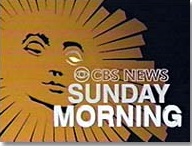



Got more questions?
Use my “Ask a Question” form and I’ll get back to you as quickly as I can.
What are the MODULES in the Class?
If you’re the kind of person who loves details, here are some of the details I’ve sent to people who’ve asked:
What are the Modules in the Class?
SECTION A – TABLE OF CONTENTS
- [HOHB2-A01] Welcome to Hands-on-Harmony! (Section C PDF is on this page)
- [HOHB2-A02] Chords and How to Build Them
- [HOHB2-A03] The Family of C: How to Play Chords and Progressions
- [HOHB2-A04] Student Takeaways and Tips from DHC: Passing Tones, Subprogressions, and Different Left Hand Chords
- [HOHB2-A05] The 1-6-2-5 Progression in the Keys of F and G
- [HOHB2-A06] Student Takeaways: Playing 1-6-2-5 Progression in C, F, and G
- [HOHB2-A07] Exploring the A Minor Scale, Modes, and Progressions
SECTION B – TABLE OF CONTENTS
- [HOHB2-B01] Chord Positions in C Major and A Minor (Section C PDF is on this page)
- [HOHB2-B02] How to Create and Alter Dominant Chords
- [HOHB2-B03] The 2-5-1-6 Progression
- [HOHB2-B04] Student Takeaways from the 2-5-1-6 Progression
- [HOHB2-B05] Playing the Pachelbel Canon in C
- [HOHB2-B06] Student Takeaways from Pachelbel’s Canon
- [HOHB2-B07] Progression 4 and the Diminished Chord
- [HOHB2-B08] Student Takeaways from Progression 4
- [HOHB2-B09] Modulating Using 2-5-1
- [HOHB2-B10] Student Takeaways from the 2-5-1 Modulation Exercise and the Course
- [HOHB2-B11] Ear Candy Glissandos
SECTION C – Table of Contents
- [HOHB2-C01] (Section C PDF is on this page)
- [HOHB2-C02] Meet the C Family
- [HOHB2-C03] Student Takeaways from “Meet the C Family”
- [HOHB2-C04] Descending Bassline in “Meet the C Family”
- [HOHB2-C05] The Gsus Chord
- [HOHB2-C06] Meet the G Family
- [HOHB2-C07] Student Takeaways from “Meet the G Family”
- [HOHB2-C08] Modulating Exercise 1
- [HOHB2-C09] Student Takeaways from Modulating Exercise 1
- [HOHB2-C10] The 2-5 Progression in Modulating Exercise 1
- [HOHB2-C11] Analyzing the “Modulating Tune Practice” Handout and Student Takeaways
- [HOHB2-C12] Reharmonizing “Twinkle, Twinkle, Little Star”
- [HOHB2-C13] “Season of the Night” and Course Wrap-Up
(See the next toggle to see the “Syllabus”)
The Class SYLLABUS
(If you like details, here’s the class syllabus):
From the “Hands on Harmony” [Harmony & Theory] Syllabus
In “Hands on Harmony” we start with a SINGLE NOTE and then go through the 3 phases of chord-construction: Expansion, Alteration & Substitution, all at your own pace.
You go as far as you want each session, then apply what you learn in the exercises, warmups and tunes.
Most importantly, this is taught specifically for harpists – using the way our instrument works – with lots of ‘hands-on’ examples so you can practice what you’re learning and literally get it ‘into your fingers.’ The class covers the four quadrants of basic tonal and jazz harmony as well as covering ‘families’ of chords and basic modulation skills.
HOW THE CLASS WORKS
The self-paced classroom includes a series of video trainings, each of which includes a downloadable audio file. There’s one multi-page PDF for the course contains material for all the trainings.
SKILLS & TOOLS
By the end of the class, you’ll know how to enrich the harmony of pieces and know how to build the chords you see when you read a lead sheet. You’ll learn:
- How to read CHORD SYMBOLS and what the different elements of the symbol mean.
- How to EXPAND chords, from single notes to triads, 7ths, 9th, 11ths and 13th and when that’s likely to sound good (or bad!).
- How ALTER chords – by adding a b9, #9, b5 or #5 – to make them richer (and what chords you’ll be most likely to want to alter!).
- How to SUBSTITUTE one chord for another to ‘reharmonize’ a piece, which substitutions are simplest, and which chords you’re most likely to substitute
- How PROGRESSIONS work, how to look for them in the music you already play and how you can use them for improv, or to practice the skills of expanding, altering and substituting chords.
- How to MODULATE from one key to another using a “diversion” and a power progression
- How to ‘psyche out’ a LEAD SHEET to look for members of the same chord family, so you can more easily see where you need to shift your levers or pedals.
SAID ANOTHER WAY, these are the principles you’ll learn:
- Extension: How to build chords up from single notes to triads, 7th chords, 9th & 11th chords
- Alteration: How to add flavor to a chord by raising or lowering specific notes (eg: b9, #9, b5, #5, etc.)
- Substitution: How to ‘reharmonize’ music by using one chord to substitute for another (eg: using an Amin as a substitute for a C Maj chord)
- Voicing: How to change the sound of chords, or make them fit your hand better by changing the order of notes and the spacing between them
- Progressions: How sequences of chords create harmonic ‘movement’ and what progressions you’re likely to see over and over again in jazz and improv
- Modulation: How to shift from key to key smoothly
- Families: How to identify chords that all belong to the same tuning, so you don’t have to constantly worry about exactly how to spell them (and whether or not you have to change a lever or pedal)
SCHEDULE
- Length: This class was originally created as a one-day, 6-hour retreat. But most people now pace the class out for several weeks.
- Learning/Practice Time: The learning time is approximately 6 hours. You should expect to spend at least another 6 hours practicing with the examples.
- When? Available all the time for self-paced learning. In addition, we usually run this class live 2-3 times a year, either as an all-day retreat or over several weeks including one or more live Q&A masterclass sessions.
- Access: For non-Academy-members, access is usually for 6 months
STUDENT PERSPECTIVE
Margi Miller is one of the student liaisons for Hip Harp Academy. She was also one of the Academy’s first students. I asked her to describe her experience with this class:
I always wondered what made some harp players pull my heart strings and astonish me with their beauty, and others “not so much”. Here’s where I found out. The difference is in the harmonies and the great lessons on extending the harmonies. You will LOVE this. It will totally change your playing.
OFFICIAL COURSE MINI-DESCRIPTION
This essential course is always available for “at your own pace” learning because it gives you a theory and harmony foundation specifically for HARP – with hands-on exercises that get the harmony directly into your fingers. Once or twice a year I run a virtual retreat where we go through it all together, and you can ask questions when I’m there live to answer them. ($297 when purchased separately)
Share this page with your friends
© Deborah Henson-Conant / HipHarp.com ∙ Privacy
